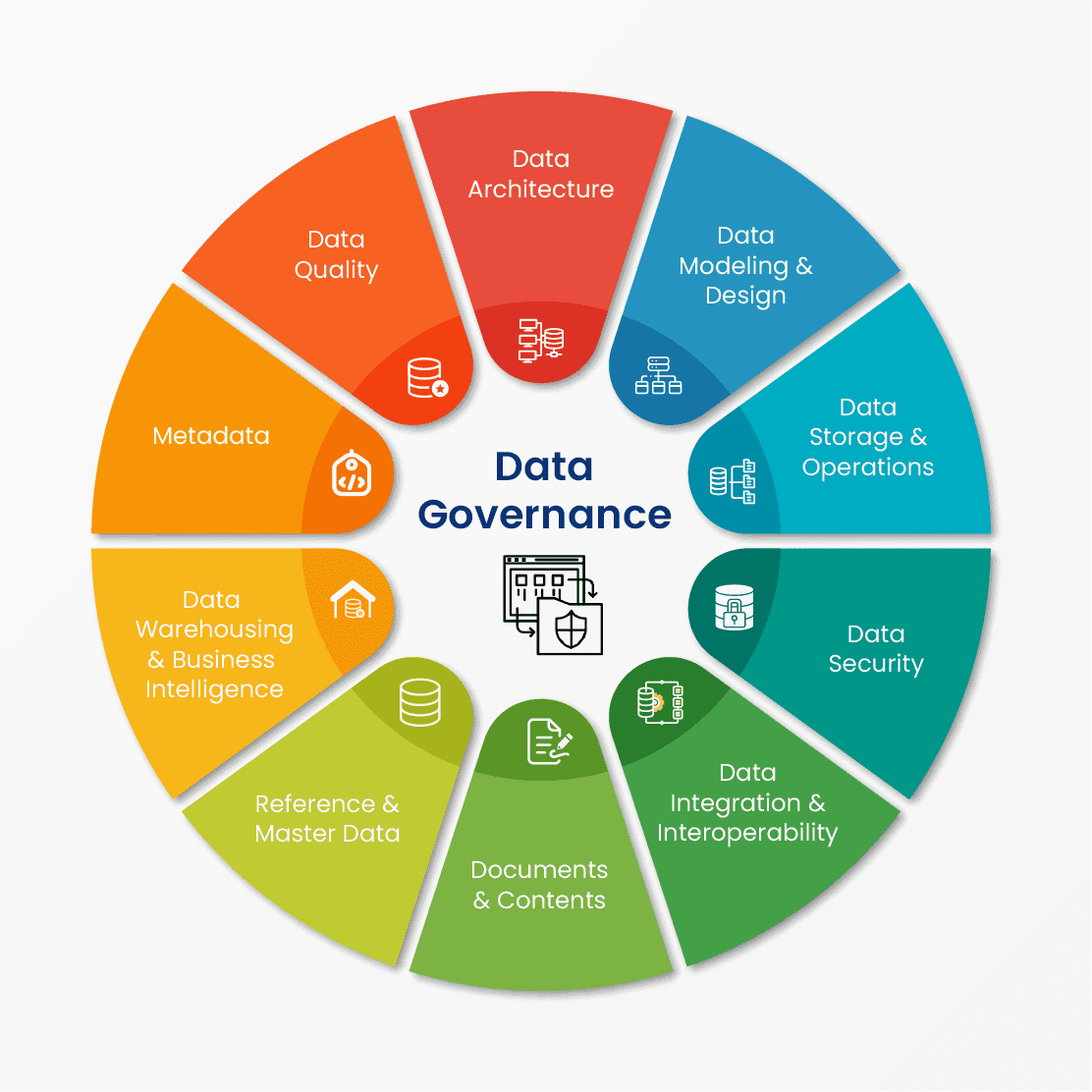- October 30, 2023
- Posted by: Kavitha V Amara
- Category: Data engineering

In the hyper-connected business landscape, the currency that fuels innovation and drives decision-making is data. From customer preferences to market trends, organizations are inundated with information. However, the true challenge lies in transforming this abundance of data into actionable insights. This is where practical data governance steps in as the linchpin for success. By implementing robust data governance practices, businesses ensure compliance and security and unlock the full potential of their data assets.
Data Governance: A Comprehensive Overview
Data governance encompasses well-defined processes and protocols to manage internal and external data within an organization efficiently. It harmonizes human resources, procedural frameworks, and technological infrastructure to foster a comprehensive understanding of data, thereby improving the status of a critical enterprise asset. Data governance entails overseeing an enterprise’s data’s availability, usability, integrity, and security by established internal standards, policies, and regulations. A robust data governance framework guarantees that data remains uniform, understandable, accurate, complete, reliable, secure, and easily accessible.
This holistic approach to data governance encompasses a wide array of domains, including data architecture, modeling, storage, operational processes, security measures, interpretability, interoperability, document management, content handling, reference and master data, data warehousing, business intelligence, metadata management, and data quality assurance. It lays the groundwork for effectively standardizing, integrating, safeguarding, and storing corporate data.
The primary objectives of a well-structured data governance initiative include:
- Mitigating data security risks
- Establishing internal protocols for data utilization
- Ensuring compliance with regulatory requirements
- Enhancing both internal and external communication channels
- Amplifying the intrinsic value of data
- Furnishing a resilient foundation for the sustained growth and continuity of the organization through prudent risk management and optimization strategies.
Since data governance initiatives have far-reaching implications at enterprises’ strategic, tactical, and operational levels, they must be treated as an ongoing and iterative process. This approach ensures that data is efficiently organized and utilized within the organization’s context and aligned with other concurrent data projects.
The Significance of Data Governance
- Defining Data Governance: Data governance is the blueprint that dictates who manages data, what processes are in place, and how data is maintained. A prominent example is Walmart, which manages petabytes of data daily. Their robust governance framework ensures that data is accurate and available across thousands of stores worldwide.
- The Data Explosion: Take the healthcare industry, for instance. With the proliferation of electronic health records (EHRs), hospitals and clinics grapple with immense volumes of patient data. Effective governance is crucial not only for compliance with regulations like HIPAA but also for ensuring the integrity and security of sensitive information. 2023, the healthcare sector alone will generate over 2.5 exabytes of data.
- Compliance and Risk Management: In 2018, the General Data Protection Regulation (GDPR) emerged, transforming how businesses handle personal data. Non-compliance can lead to fines of up to €20 million or 4% of the company’s global annual turnover. This emphasizes the critical role of data governance in regulatory adherence and risk mitigation.
Critical Components of Effective Data Governance
- Clear Data Ownership: Consider a financial institution like JPMorgan Chase. They designate specific data stewards responsible for various data sets. This clarity ensures accountability and the maintenance of high-quality data. For instance, in 2023, JPMorgan Chase’s data governance team reduced data discrepancies by 30% through diligent ownership assignments.
- Data Quality Management: Amazon’s success is partially attributed to its meticulous data quality practices in the retail sector. Automated validation and constant monitoring ensure that product listings, customer reviews, and order details remain accurate and reliable. This commitment to data quality has led to a 15% increase in customer satisfaction ratings in 2023.
- Metadata Management: a global streaming giant, Netflix relies heavily on effective metadata management. This involves tagging content with information like genre, actors, and viewer preferences. It enables precise content recommendations and a seamless user experience. In 2023, this strategy contributed to a 20% increase in user engagement and a 25% decrease in content search time.
- Data Privacy and Security: Recent data breaches have highlighted the need for robust privacy and security measures. For example, Equifax, a consumer credit reporting agency, suffered a significant breach in 2017, compromising the personal information of nearly 147 million individuals. Effective data governance includes encryption, access controls, and regular security audits. In 2023, Equifax implemented advanced encryption protocols, reducing the risk of data breaches by 40%.
Explore Our Data’s Potential Link: solutions or services.
Challenges and Best Practices
Challenges:
Implementing effective data governance isn’t without hurdles. One common challenge is resistance from employees accustomed to existing data management practices. Additionally, keeping up with evolving regulatory landscapes poses a continuous challenge. For example, in 2023, introducing new data privacy regulations in Europe forced many multinational companies to adapt their governance frameworks.
Best Practices:
- Begin with a Solid Foundation and expand to Greater Horizons: At the core of data governance lie three foundational pillars: people, processes, and technology. Establishing a solid foundation starts with assembling the right team, developing robust strategies, and integrating technology seamlessly into these processes. Without the appropriate individuals driving the initiative, constructing effective methods for the technical implementation of data governance becomes challenging. Therefore, the initial step for any organization is to identify and onboard the right talent. With the right team, you can construct the necessary processes and acquire the technology required to execute the task.
- Identify Critical Data Elements: Prioritize data elements crucial for business operations. This ensures focused governance efforts where they matter most. In 2023, a leading e-commerce company, eBay, identified critical customer behavior data, resulting in a 25% increase in targeted marketing effectiveness.
- Treat Data as a Strategic Resource: Just as companies allocate resources for R&D, data should be viewed as a strategic asset. Investment in its governance yields long-term benefits. In 2023, companies that viewed data as a strategic asset reported a 30% increase in ROI from data-driven initiatives.
- Set Policies for the Data Lifecycle: From acquisition to disposal, establish clear policies. This ensures that data is managed consistently and securely throughout its lifecycle. In 2023, companies with well-defined data lifecycle policies reduced data storage costs by 15%.
- Involve Business Users in Governance: Collaborate with business units to understand their specific data needs. This fosters a culture of data ownership and ensures alignment with organizational objectives. In 2023, companies that actively involved business users in governance reported a 20% increase in customer data accuracy.
Emerging Trends in Data Governance
Artificial Intelligence and Machine Learning are increasingly pivotal in automating governance processes. Additionally, Blockchain technology is being explored to enhance data security and transparency. With the rise of Edge Computing, managing data at the source becomes crucial. These trends underscore the dynamic nature of data governance in the digital age.
Presently, organizations are accumulating and managing increasingly vast amounts of data daily. In the aftermath of the COVID-19 pandemic, with a significant portion of the workforce operating from remote locations, employees frequently handle sensitive data outside traditional office environments. This shift to a remote work scenario can lead to reputational harm and financial liabilities without proper governance. The data governance market is anticipated to grow at a compound annual growth rate (CAGR) of 21.44% from 2021 to 2026, according to a research report from Mordor Intelligence for 2021. It is projected to reach a market value of over USD 5.28 billion by 2026.
Request a Data Governance Consultation.
Wrapping Up
In the data-driven landscape of 2023, effective data governance is not just a competitive advantage; it’s a prerequisite for sustainable success. By acknowledging its significance, understanding its components, and adopting best practices, businesses can harness the true power of their data. As we navigate the complexities of an interconnected world, robust data governance will be the compass that guides us toward informed, strategic decisions.





